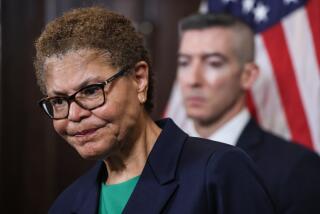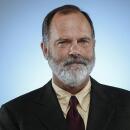Riot-Recovery Bank Stands at Crucial Phase
- Share via
In a South-Central Los Angeles church not far from where rioters left a community in tatters five years ago, about 75 lawyers, executives, pastors, bankers, bureaucrats, activists and residents gathered recently to collaborate on what may represent the most significant step in the area’s long, painful recovery.
Their plans do not include acts of charity. They are about investment and return, about job creation through business growth under the banner of the Los Angeles Community Development Bank. And by all admissions, they are overdue.
Two promising, frustrating years since it was first conceived--and a year since it began operating in earnest--the community bank, a unique institution backed by federal funds and a group of commercial banks, now stands at a critical juncture: Either it will begin to pump money into poor neighborhoods, infusing them with jobs and new vitality, or it will fizzle out in a trickle of good intentions.
If it succeeds, thousands of residents could get jobs and buy homes; poor neighborhoods could get businesses, banks, shoe stores, supermarkets and other long-sought amenities; vacant lots that now bespeak the area’s despair could be filled with symbols of its promise. But if it fails, it will take economic and political dreams with it, and it will leave both President Clinton and Mayor Richard Riordan with long, lingering headaches.
“The next year,” bank chairman and prominent Los Angeles lawyer Gil Ray said simply, “is critical.”
That sentiment was widely echoed recently by bank officials and executives seeking the bank’s help. A number of the participants grumbled about how long it has taken for the bank to begin making loans, but they applauded its careful steps to date, and they expressed hopes that the pipeline will soon open up.
Backed by $740 million that Riordan was instrumental in securing, bank officials say they have enough resources to play an important role in the economic revitalization of the city’s poorest neighborhoods. As of today, however, they have succeeded in lending money to just 13 companies, a varied collection of enterprises that includes a Western-style clothing maker flirting with leaving Los Angeles, a small supermarket destroyed in the 1992 riots and a graphics company wiped out by the 1994 earthquake.
Total value of those loans: $7.6 million, enough to preserve or attract about 200 inner-city jobs, but a paltry sum in comparison to the depth of poverty in America’s second-largest city.
Although more loans have been approved and still more are in the pipeline--a total of 26 loans with a value of about $25 million have received the bank’s approval--the effort has tested the patience of some backers.
“I’ve had frustrations,” said Rockard J. Delgadillo, an assistant deputy mayor in Riordan’s office of economic development and an ardent supporter of the bank. “It’s taken them a long time to get themselves set up.”
Bank officials agree. But they, like Delgadillo, believe that the delays are now behind them, and that the money should begin flowing more rapidly in coming months. And they hope the results will become increasingly visible where they are most needed: in poor neighborhoods across the city and county of Los Angeles.
All of that makes the Community Development Bank both economic test case and political parable.
Its progress in soliciting public and private backing is evidence of Riordan’s tremendous ability to lobby Washington and local business leaders for support. Its problems finding qualified borrowers demonstrate the difficulties inherent in confronting big, messy problems such as urban poverty. And its success or failure not only could influence Los Angeles’ poorest neighborhoods, but also could determine whether the federal government again invests so heavily in community development banks as an economic recovery device.
“There are a lot of people watching this community development bank,” said Wendy Greuel, Southern California representative for the U.S. Department of Housing and Urban Development. “Everyone involved has the same sense of urgency.”
For Los Angeles, the bank that now holds so much promise--and that comes with such large stakes--began as a consolation prize.
In December 1994, Mayor Riordan was preparing for his annual Christmas party when he received word that the federal government had rejected Los Angeles’ application for an empowerment zone, which would have given tax breaks to companies willing to do business in the city’s poor neighborhoods. Although Riordan publicly put the best spin on that decision, sources close to him say he was incensed--so much so that he refused to join President Clinton’s conference call congratulating the winners.
So Clinton, who badly needed to be able to count on California in his bid for reelection and who coveted Riordan’s support, set out to make the mayor happy. The city was selected to receive a “supplemental empowerment zone,” and then-Secretary of Housing and Urban Development Henry Cisneros and other top Washington officials proposed that the city receive the first federally backed Community Development Bank.
Riordan, a lawyer and venture capitalist who has negotiated deals his whole professional life, played hard to get.
In what sources say were a series of sometimes crisp sessions, the federal officials pitched the idea to the mayor, then offered to chip in federal money to back it. Riordan made clear that he was not impressed, the sources said, prompting Cisneros to up the ante. Eventually, the federal government agreed to provide $450 million to local economic development money, of which $430 million went to the bank.
After negotiating with the federal government for its support, Riordan turned to private banks. By the time he was through, a group of commercial banks had agreed to co-lend $310 million, vastly boosting the resources at the disposal of the Community Development Bank.
“What was envisioned as the consolation prize,” said Ray, “has in many ways become the first prize.”
Just having money was not enough, however.
Local officials needed to set up lending criteria that would identify borrowers who had been neglected by private banks but who nevertheless seemed a safe bet as borrowers, a delicate balance. The bank is required to see that every $35,000 in loans generated or saved at least one job. Any company that gets financing from the bank is required to hire at least 51% of its new workers from inside designated poor neighborhoods.
Those rules are more complicated than most banks face, and the community bank board had few role models. South Shore Bank in Chicago, the nation’s first successful community development lender, offered some valuable lessons. But South Shore is a fraction of the size of what is being undertaken in Los Angeles. Also, South Shore is a private institution, meaning that it works with a different set of rules and regulations from those that would govern Los Angeles’ bank.
As a result, it took time to sort out regulations governing the Los Angeles bank, to draft rules for making loans, to round up federal and private money, to hire a chief executive officer and to find a headquarters, Ray noted.
The City Council approved creation of a governing board for the bank July 5, 1995. It was not until a year later that it made its first loan--to a textile company that was in danger of going out of business. Instead, its employees bought the company, and its 100-plus jobs stayed in Los Angeles.
“Clearly, the start-up took longer than I would have liked,” Ray said. “But we were creating a new company. . . . These things take time. They always take longer than you would like.”
The delays have been costly, both in terms of public relations and economic development: A contact lens maker left for Torrance because it could not afford to wait for the bank to get its act together on lending; the same was true for an automobile parts recycler and a major tortilla maker, both of which relocated outside Los Angeles while the bank tried to get up and running. All three took jobs and revenue with them.
An active community bank might have saved those and other companies and lured still more. But some economists question how deeply the bank ever can affect the overall economy of Los Angeles.
“A little bit’s better than nothing,” said J. Eugene Grigsby, a professor at UCLA’s School of Public Policy. But he added: “It’s unrealistic to think that the bank, even if it were running at maximum capacity, would have much measurable impact on the economy.”
Similarly, Occidental College professor Peter Dreier said he believes the community development bank is a good idea, but added that its reach may be limited in confronting a problem as complex and sprawling as urban poverty in Los Angeles.
“The Community Development Bank is one little strategy,” he said. “It’s a good idea, but it’s not a panacea, and it came with high expectations about what this agency can deliver. . . . It’s one piece of ammunition in what should be a larger arsenal. The problem is that there isn’t much of an arsenal there.”
In part, Dreier said, that is because the bank’s focus, by definition, is geographic. The bank is authorized to make loans to groups and companies inside the city’s empowerment zone, an area that includes parts of the city where an average of 35% of the residents live below the poverty level.
But job creation is not easily accomplished within small geographic areas, Dreier said. Indeed, he and other economists argued in a recent study that a regional approach to poverty would help the poor and spur growth. The Community Development Bank, by contrast, is highly local.
To all of that, Riordan and other backers of the bank readily admit that it is not the lone solution to poverty.
“This is not a magic pill,” Riordan said. “Nothing is.”
The mayor, however, stressed that he believes the bank’s methodical steps so far have left it well-positioned to make a difference in the months and years ahead. “Making business loans is an extremely difficult thing to do,” Riordan said. “You can’t expect somebody to make a stupid loan. I think they’ve been moving carefully and correctly.”
Likewise, C. Robert Kemp, the bank’s much-admired chief executive officer, said officials carefully spent months wading through a large backlog of loan applications and trying to help companies develop business plans. In recent months, the bank has gotten through the old applications and has begun developing more promising loan prospects--as well as expanding its community outreach.
Delgadillo, who has shepherded the project for the mayor’s office, said he feels the tide turning in subtle ways. At business gatherings where he used to have to buttonhole bankers and business people, Delgadillo said, “Now they’re the ones coming up to me.”
What remains to be seen is whether the glimmerings of optimism surrounding the bank will be realized.
In Kemp’s vision, the bank will help create businesses and expand others; unemployment in poor areas could drop by 25% or more. More workers will lure services such as bank branches and supermarkets, both badly needed in South Los Angeles and beyond. Greater community investment will give residents a stronger sense of loyalty to their neighborhoods, reducing blight such as graffiti and dumping.
Gains toward some of those goals will be difficult to measure. Eliminating community blight, for instance, is a mission of the Police Department and various other city agencies as well as the Community Development Bank, so even if there are reductions, it may be hard to know who deserves credit.
But on one criteria for the bank’s success, skeptics and supporters, executives and politicians all agree: If it helps create jobs, it has been a success; if it does not, it will have failed.
“People should look at us and ask: Did we create and retain jobs,” Ray said. “Did we make it happen? Were we the catalyst? Those are fair questions.”
(BEGIN TEXT OF INFOBOX / INFOGRAPHIC)
The Bank’s History
The Los Angeles Community Development Bank has been slow to take hold, but supporters believe it is poised to begin helping poor neighborhoods in the city and county.
December 1994: Federal government announces identification of empowerment zones, an idea born of the Los Angeles riots. Los Angeles is not included in the original list, so angering Mayor Richard Riordan that he declines to join President Clinton’s conference call congratulating the winners.
January-March 1995: Riordan and Clinton administration officials reach a deal for a Los Angeles-based community development bank, in part as a “consolation prize” after the city’s failure to win an empowerment zone.
May 1995: Vice President Al Gore announces award of $450 million to the city of Los Angeles and Los Angeles County; of that money, $430 million is used to fund the bank. Discussions begin on how the bank should be run.
July 1995: City Council approves agreement establishing the bank, including rules for picking its board members.
May 1996: Bank board hires C. Robert Kemp as chief executive. The appointment of Kemp, a veteran of government, banking and community development, cheers supporters, who urge quick action on making loans.
July 1996: Bank issues first loan. Since then, it has approved and funded a dozen more, with still more approved but not yet funded.
May 29, 1997: Bank board holds annual meeting.
More to Read
Sign up for Essential California
The most important California stories and recommendations in your inbox every morning.
You may occasionally receive promotional content from the Los Angeles Times.











